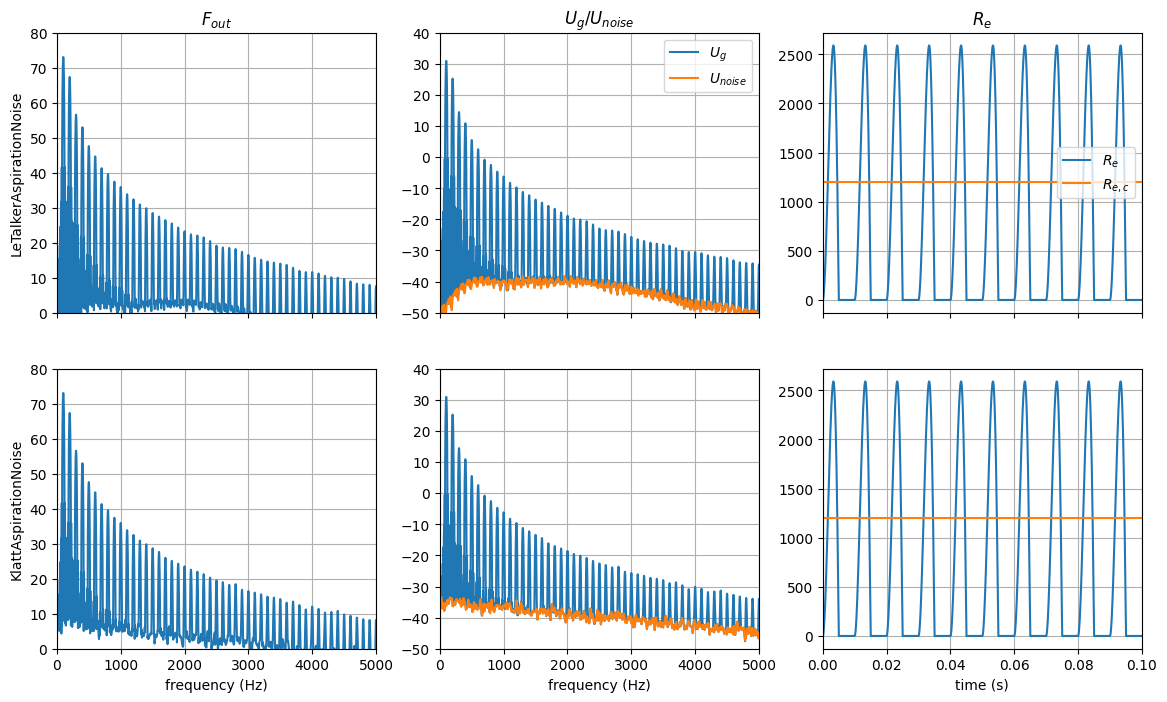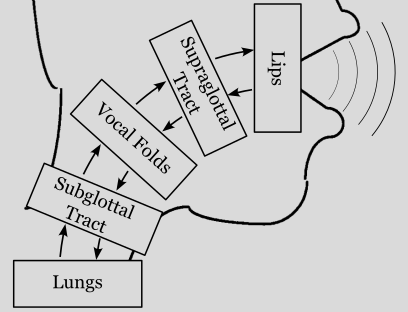[1]:
import numpy as np
from matplotlib import pyplot as plt
from scipy.signal import welch
from scipy.fft import next_fast_len
import letalker as lt
Python classes to model various Elements of Voice Production Mechanism#
pyLeTalker package divides the voice production model into 5 distinctive elements: lungs, trachea (subglottal vocal tract), vocal folds (larynx), (supraglottal) vocal tract, and lips. Each element is implement as a concrete subclass of the abc.Element abstract class. A same wave reflection model can be used for both the trachea and vocal tract, thus there are 4 types of elements, which are represented by abstract subclasses of abc.Element:
name |
description |
|---|---|
|
Lungs / respiratory pressure generator, receiving incidental backward pressure, producing forward pressure |
|
Tubes in which incidental pressure waves are propagating in both forward and backward directions |
|
Larynx, injecting the oscillatory behavior to the propagating incidental pressures |
|
Lip, transforming the incidental pressures to radiated sound pressure output |
|
Aspiration noise generator to be attached to |
The wave reflection model treats the voice production system as a chain of these elements, and at each connection the incidental pressure signals travels both forward and backward. The elements with full I/O (abc.VocalTract and abc.VocalFolds) have 4 ports while the terminating elements, both the source (abc.Lungs) and sink (abc.Lips), have 2 pressure ports exposed as illustrated below.
Each Element class has its own Runner and Result classes within and instantiated by the Element class.
The Runner class is instantiated by Element.create_runner() method, which if needed converts set of user-friendly model parameters to an optimized parameterization for simulation. At each time step n, Runner.step() method of every element is executed to updates element’s states given current input samples \(F_{in,n}\) and \(B_{in,n}\) and outputs \(F_{out,n+1}\) and \(B_{out,n+1}\). Runner objects also saves selected internal signals for later analysis.
Once the simulation completes (i.e., calling the Element.step() of every element in a loop for the prescribed number of steps), the configurations and results are gathered fro each element as an Element.Result object via the Element.create_result() method.
abc.Lung classes#
There are 3 builtin lung classes:
name |
description |
|---|---|
|
Propagates 90% of the respiratory pressure \(P_{L,n}\) and reflects 80% of incidental backward wave \(B_{in,n}\) |
|
Outputs 100% of \(P_{L,n}\) and 0% of \(B_{in,n}\) |
|
No respiratory pressure and only reflects the incidental backward wave \(B_{in,n}\) (80%) |
[2]:
# create input signal generators
PL = lt.Constant(1.0, transition_time=0.01) # constant level at 1.0, starting at t=0.01 s
Bin_generator = lt.SineGenerator(100, transition_time=0.015) # 100 Hz sine wave starting at t=0.015 s
# create the base lung classes
lungs = {
"LeTalker": lt.LeTalkerLungs(PL),
"Open": lt.OpenLungs(PL),
"Null": lt.NullLungs(),
}
# create their simulation runner objects
n = round(lt.constants.fs*0.1) # number of samples to simulate
runners = [lung.create_runner(n) for lung in lungs.values()]
Bin = Bin_generator(n) # backward pressure input
Fout = np.empty((n, len(runners))) # forward pressure output
for i, b in enumerate(Bin):
# Compute the next states of fsg & blung
for j, runner in enumerate(runners):
Fout[i, j] = runner.step(i, b)
t = Bin_generator.ts(n)
fig, axes = plt.subplots(1, 2, sharex=True, figsize=[12, 4])
axes[0].plot(t, PL(n), label="$P_L$")
axes[0].plot(t, Bin, label="$B_{in}$")
axes[0].legend()
axes[0].set_xlabel('time (s)')
axes[1].plot(t, Fout)
axes[1].legend(lungs,loc='lower left')
axes[1].set_xlabel('time (s)');
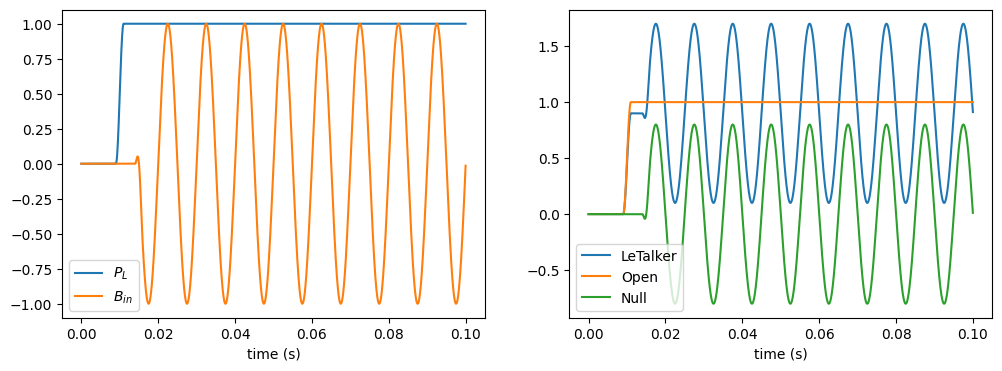
abc.Lip class: LeTalkerLips#
There is one builtin class, LeTalkerLips, which is an implementation of Ishizaka-Flanagan model, a circular piston in an infinite baffle.
[3]:
# create the lip class with time-varying lip crosssectional area
lips = lt.LeTalkerLips(upstream=3)
# create input signal generators (white noise)
Fin_generator = lt.WhiteNoiseGenerator()
# create their simulation runner objects
n = round(lips.fs) # number of samples to simulate
runner = lips.create_runner(n)
Fin = Fin_generator(n) # generate forward pressure input samples
Bout = np.empty(n) # backward pressure output
for i, f in enumerate(Fin):
# Compute the next states of bout
Bout[i] = runner.step(i, f)
res = lips.create_result(runner)
t = res.ts
N = res.fs // 10
nfft = nfft = next_fast_len(lips.fs // 10)
f, H = next(lips.iter_freqz(n, forN=nfft // 2 + 1, include_nyquist=True))
Pp = welch(res.pout, nperseg=N, noverlap=N // 2, nfft=nfft)[1] # / (lips.fs / 2)
Pb = welch(Bout, nperseg=N, noverlap=N // 2, nfft=nfft)[1] # / (lips.fs / 2)
with np.errstate(divide='ignore'):
HdB = 20 * np.log10(np.abs(H))
PpdB = 10 * np.log10(Pp / 2)
PbdB = 10 * np.log10(Pb / 2)
fig, axes = plt.subplots(1, 2, sharex=True, sharey=True, figsize=[12, 4])
axes[0].plot(f, PpdB, label="estimated psd")
axes[0].plot(f, HdB[0, :], label="model response")
axes[0].set_xlabel("frequency (Hz)")
axes[0].set_title("$P_{out}$")
axes[0].legend()
axes[1].plot(f, PbdB, label="estimated psd")
axes[1].plot(f, HdB[1, :], label="model response")
axes[1].set_xlabel("frequency (Hz)")
axes[1].set_title("$B_{out}$");
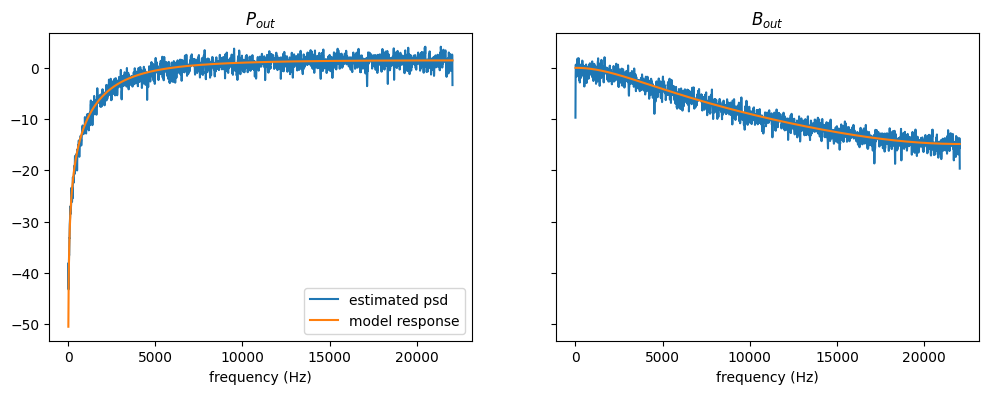
abc.VocalTract#
There are two builtin vocal tract models: LeTalkerVocalTract & LossyCylinderVocalTract.
pyLeTalker uses the exact same vocal tract area data that were distributed in LeTalker Matlab program. They are 10 vowels (+1 modified version of uu) and another for a trachea, and they are found in the lt.constants.vocaltract_areas dict and its keys can also be found in:
[4]:
print(f'{lt.constants.vocaltract_names=}')
lt.constants.vocaltract_names=('aa', 'ii', 'uu', 'ae', 'ih', 'eh', 'ah', 'aw', 'uh', 'oo', 'uumod', 'trach')
These keys for the vocal tract area can be specified as the areas argument of the LeTalkerVocalTract constructor.
The following code runs 4 different vocal tract models and plots the PSD estimates of the output pressure, driven by only one of the input pressure port. Note that these are open-loop behaviors and not the same as a simulation with lung and lip models attached to them (i.e., closed-loop simulation). Most notably, the LossyCylinderVocalTract model only attenuates and delays the signal. Only in a closed-loop configuration, this model will induce a resonance pattern.
[5]:
# create the lips class with time-varying lip crosssectional area
vt_models = {
"aa": lt.LeTalkerVocalTract("aa", atten=lt.constants.vt_atten),
"ii": lt.LeTalkerVocalTract("ii", atten=lt.constants.vt_atten),
"uu": lt.LeTalkerVocalTract("uu", atten=lt.constants.vt_atten),
"cylinder": lt.LossyCylinderVocalTract(
44 * lt.constants.vocaltract_resolution, 5, atten=lt.constants.vt_atten
),
}
# - lt.constants.vt_atten = 0.002
n_models = len(vt_models)
# create input signal generators (white noise)
in_generator = lt.WhiteNoiseGenerator()
# create their simulation runner objects
n = round(lips.fs) # number of samples to simulate
runners = [model.create_runner(n) for model in vt_models.values()]
# generate input samples and preallocate output arrays
x = in_generator(n)
y = np.zeros_like(x)
outputs = np.empty((n, n_models, 2, 2)) # pressure outputs
# run the simulation
for j, runner in enumerate(runners): # for each model
for k, inputs in enumerate([(x, y), (y, x)]): # for each input
for i, (f, b) in enumerate(zip(*inputs)): # for each time sample
outputs[i, j, k] = runner.step(i, f, b)
fs = lt.constants.fs
N = res.fs // 20
nfft = nfft = next_fast_len(N)
# PSD estimation
f, Pyy = welch(outputs, nperseg=N, noverlap=N // 2, nfft=nfft, axis=0)
with np.errstate(divide='ignore'):
PyydB = 10 * np.log10(Pyy / 2)
# plot PSDs
fig, axes = plt.subplots(2, 2, sharex=True, sharey=True, figsize=[12, 8])
for i in range(2): # input
for j in range(2): # output
axes[i, j].plot(f, PyydB[:, :, i, j])
axes[i, j].grid()
axes[0, 0].set_ylim(-40, 10)
fig.suptitle("Open-loop behaviors of vocal tract models")
axes[0, 0].set_title("Forward Output PSD")
axes[0, 1].set_title("Backward Output PSD")
axes[0, 0].set_ylabel("Forward Input Only\n(dB)")
axes[1, 0].set_ylabel("Backward Input Only\n(dB)")
axes[1, 0].set_xlabel("frquency (Hz)")
axes[1, 1].set_xlabel("frquency (Hz)")
axes[1, 0].legend(vt_models);
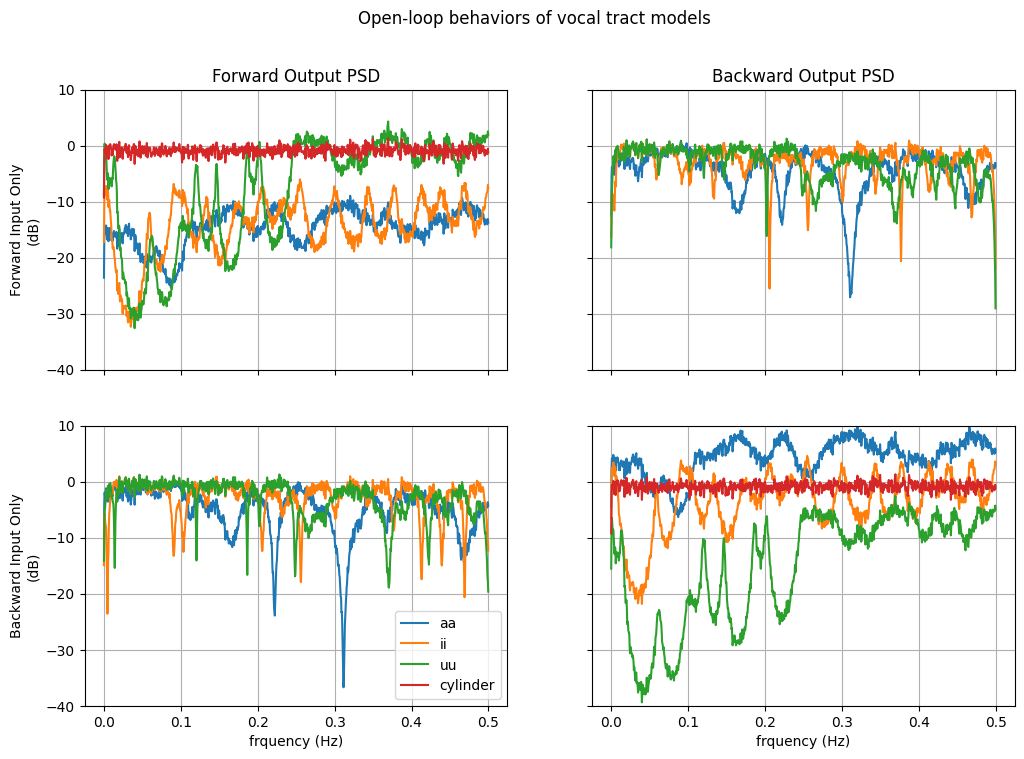
abc.VocalFolds classes#
There are 4 builtin vocal fold models in pyLeTalker:
name |
description |
|---|---|
|
Known glottal flow (simulates no vocal fold motion) |
|
Symmetric 3-mass model |
|
Symmetric kinematic model |
|
Asymmetric kinematic model |
[6]:
ug_gen = lt.RosenbergGenerator(100)
vf = lt.VocalFoldsUg(ug_gen, upstream=0.5, downstream=0.3)
# set upstream and downstream tube cross-sectional areas
# create input signal generators (white noise)
Fin_generator = lt.WhiteNoiseGenerator()
Bin_generator = lt.WhiteNoiseGenerator()
# create their simulation runner objects
n = round(vf.fs // 10) # number of samples to simulate
runner = vf.create_runner(n)
Fin = Fin_generator(n) # generate forward pressure input samples
Bin = Bin_generator(n) # generate forward pressure input samples
Bout = np.empty(n) # backward pressure output
Fout = np.empty_like(Bout)
for i, (f, b) in enumerate(zip(Fin, Bin)):
# Compute the next states of bout
Fout[i], Bout[i] = runner.step(i, f, b)
res = vf.create_result(runner)
t = res.ts
plt.plot(t, Fout, label="$F_{out}$")
plt.plot(t, Bout, label="$B_{out}$")
plt.xlabel("time (s)")
plt.legend()
[6]:
<matplotlib.legend.Legend at 0x7fcb187f79b0>
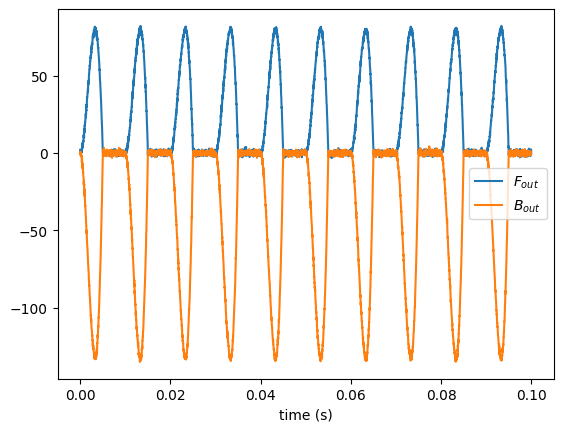
[7]:
ag_gen = lt.RosenbergGenerator(100, 0.1)
vf = lt.VocalFoldsAg(ag_gen, upstream=1, downstream=1)
# create input signal generators (white noise)
Fin_generator = lt.Constant(1.0)
Bin_generator = lt.Constant(0.1)
# create their simulation runner objects
n = round(vf.fs // 10) # number of samples to simulate
runner = vf.create_runner(n)
Fin = Fin_generator(n, force_time_axis='tile_data') # generate forward pressure input samples
Bin = Bin_generator(n, force_time_axis='tile_data') # generate forward pressure input samples
Bout = np.empty(n) # backward pressure output
Fout = np.empty_like(Bout)
for i, (f, b) in enumerate(zip(Fin, Bin)):
# Compute the next states of bout
Fout[i], Bout[i] = runner.step(i, f, b)
res = vf.create_result(runner)
t = res.ts
plt.plot(t, Fout, label="$F_{out}$")
plt.plot(t, Bout, label="$B_{out}$")
plt.plot([], [], label="$A_{g}$")
plt.legend()
plt.xlabel("time (s)")
plt.twinx()
plt.plot(t, ag_gen(n), c="C2")
[7]:
[<matplotlib.lines.Line2D at 0x7fcb181a2de0>]
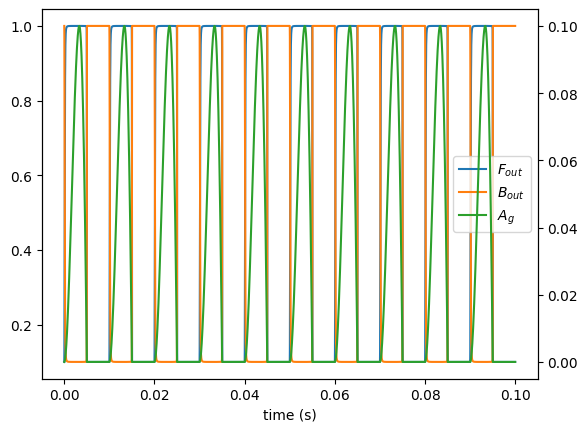
[8]:
vf = lt.KinematicVocalFolds(100, **lt.constants.male_vf_params, upstream=1,downstream=1)
# create input signal generators (white noise)
Fin_generator = lt.Constant(1.0)
Bin_generator = lt.Constant(0.1)
# create their simulation runner objects
n = round(vf.fs // 10) # number of samples to simulate
runner = vf.create_runner(n)
Fin = Fin_generator(n, force_time_axis='tile_data') # generate forward pressure input samples
Bin = Bin_generator(n, force_time_axis='tile_data') # generate forward pressure input samples
Bout = np.empty(n) # backward pressure output
Fout = np.empty_like(Bout)
for i, (f, b) in enumerate(zip(Fin, Bin)):
# Compute the next states of bout
Fout[i], Bout[i] = runner.step(i, f, b)
res = vf.create_result(runner)
t = res.ts
plt.plot(t, Fout, label="$F_{out}$")
plt.plot(t, Bout, label="$B_{out}$")
plt.plot([], [], label="$U_{g}$")
plt.legend()
plt.xlabel("time (s)")
plt.twinx()
plt.plot(t, res.ug, c="C2");
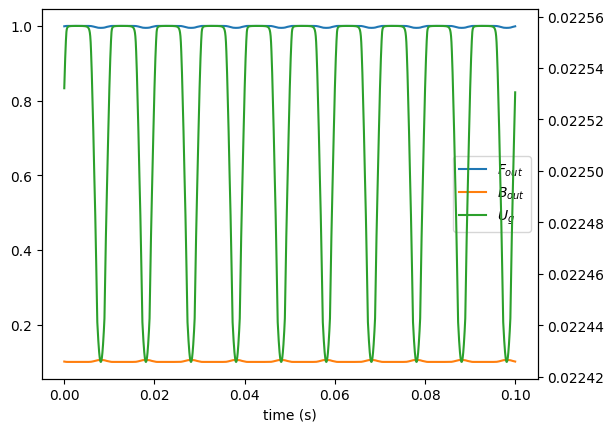
KinematicVocalFolds - Symmetric and Asymmetric Kinematic Vocal Folds#
KinematicVocalFolds is a subclass of VocalFoldsAg and generates the glottal area waveform from prescribed vocal fold geometry and motion equations.
[9]:
vf = lt.KinematicVocalFolds(100) # default (male) model with fo = 100 Hz
plt.plot(vf.ts(n),vf.glottal_area(n))
plt.xlabel('time (s)')
plt.ylabel('glottal area, $A_g$ (cm²)');
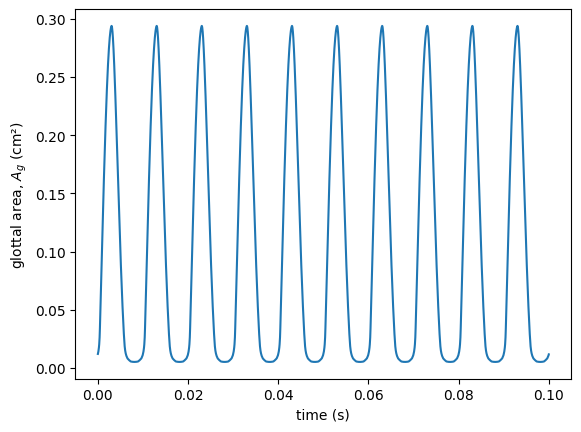
KinematicVocalFolds can also support left-right asymmetry of any of its parameters
[10]:
# 2:3 entrained biphonic phonation of the default (male) model with fo = 100 Hz and 150 Hz
vf = lt.KinematicVocalFolds([100, 150])
fig, axes = plt.subplots(1, 2, sharex=True, figsize=[16, 4])
axes[0].plot(vf.ts(n), vf.glottal_area(n).T)
axes[0].set_xlabel("time (s)")
axes[0].set_ylabel("glottal area, $A_g$ (cm²)")
x_semi = vf.xi(n).min(-1).sum(-1)
# axes[1].plot(vf.ts(n), x_semi.T)
axes[1].plot(vf.ts(n), x_semi[0], vf.ts(n), -x_semi[1])
axes[1].set_xlabel("time (s)")
axes[1].set_ylabel("glottal semi-area (cm²)");

LeTalkerVocalFolds: symmetric (linearized) 3-mass model with muscle activation controls#
[11]:
vf = lt.LeTalkerVocalFolds(
upstream=lt.constants.vocaltract_areas["trach"][-1],
downstream=lt.constants.vocaltract_areas["aa"][0],
)
# create input signal generators (white noise)
Fin_generator = lt.Constant(lt.constants.PL)
Bin_generator = lt.Constant(0.0)
# create their simulation runner objects
n = round(vf.fs // 10) # number of samples to simulate
runner = vf.create_runner(n)
Fin = Fin_generator(n, force_time_axis='tile_data') # generate forward pressure input samples
Bin = Bin_generator(n, force_time_axis='tile_data') # generate forward pressure input samples
Bout = np.empty(n) # backward pressure output
Fout = np.empty_like(Bout)
for i, (f, b) in enumerate(zip(Fin, Bin)):
# Compute the next states of bout
Fout[i], Bout[i] = runner.step(i, f, b)
res = vf.create_result(runner)
t = res.ts
fig, axes = plt.subplots(4, 1, sharex=True, figsize=[8, 8])
axes[0].plot(t, Fout, label="$F_{out}$")
axes[0].plot(t, Bout, label="$B_{out}$")
axes[0].set_ylabel("output pressures")
axes[0].set_xlabel("time (s)")
axes[0].legend()
axes[1].plot(t, res.ag[:-1])
axes[1].set_ylabel("$A_g$")
axes[2].plot(t, res.ug[:-1])
axes[2].set_ylabel("$U_g$")
axes[3].axhline(0, ls=":", lw=0.5)
axes[3].plot(t, res.displacements)
axes[3].legend(["bottom", "top", "body"])
axes[3].set_ylabel("Disp.")
axes[3].set_xlabel("time (ms)")
# fig.align_ylabels(axes)
[11]:
Text(0.5, 0, 'time (ms)')
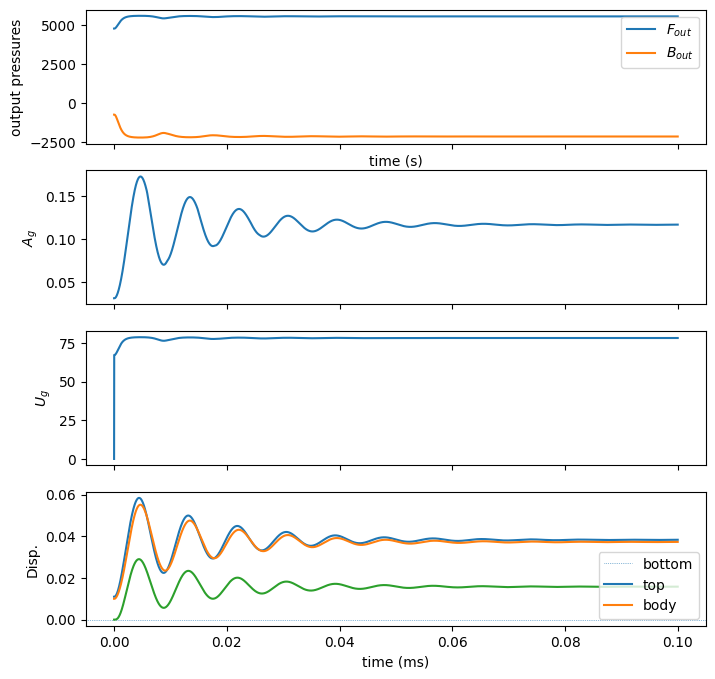
abc.AspirationNoise - Aspiration noise (turbulent noise injected at the glottis-epiglottal junction)#
There are two builtin concrete classes:
name |
description |
|---|---|
|
Bandlimited noise injected only if Reynold number is above the thresold |
|
Bandlimited noise injected at two levels depending on Reynold number |
Both of these models can be customized with different white noise generator (Gaussian, uniform, etc.) and spectral shaping filter.
[12]:
# create aspiration noise sources
lt_noise = lt.LeTalkerAspirationNoise()
kl_noise = lt.KlattAspirationNoise()
# create kinematic vocal fold models at fo=100Hz and assign the noise objects to them
kwargs = {
"upstream": lt.constants.vocaltract_areas["trach"][-1],
"downstream": lt.constants.vocaltract_areas["aa"][0],
"length": lt.constants.male_vf_params["L0"],
}
ug_gen = lt.RosenbergGenerator(100, 600)
vf_lt = lt.VocalFoldsUg(ug_gen, aspiration_noise=lt_noise, **kwargs)
vf_kl = lt.VocalFoldsUg(ug_gen, aspiration_noise=kl_noise, **kwargs)
# create their simulation runner objects
n = round(vf_lt.fs) # number of samples to simulate
lt_runner = vf_lt.create_runner(n)
kl_runner = vf_kl.create_runner(n)
# preallocate forward pressure output array (ignore backward outputs for now)
Fout = np.empty((n, 2))
# run simulation
b = [0, 0]
for i in range(n):
Fout[i, 0], _ = lt_runner.step(i, 0.0, 0.0)
Fout[i, 1], _ = kl_runner.step(i, 0.0, 0.0)
# gather the results
lt_res = vf_lt.create_result(lt_runner)
kl_res = vf_kl.create_result(kl_runner)
t = lt_res.ts
fs = lt.constants.fs
N = round(lt_res.fs * 0.1)
nfft = nfft = next_fast_len(fs)
# PSD estimation
f, Pxx = welch(
[lt_res.ug, kl_res.ug], nperseg=N, noverlap=N // 2, nfft=nfft, axis=-1, fs=fs
)
_, Pyy = welch(Fout, nperseg=N, noverlap=N // 2, nfft=nfft, axis=0, fs=fs)
_, Pzz = welch(
[lt_res.aspiration_noise.unoise, kl_res.aspiration_noise.unoise],
nperseg=N,
noverlap=N // 2,
nfft=nfft,
axis=-1,
fs=fs,
)
PyydB = 10 * np.log10(Pyy / 2)
# plot PSDs
fig, axes = plt.subplots(2, 3, figsize=[14, 8], sharex="col", sharey="col")
axes[0, 0].plot(f, PyydB[:, 0])
axes[0, 0].grid()
axes[0, 0].set_xlim((0, 5000))
axes[0, 0].set_ylim((0, 80))
axes[0, 0].set_title("$F_{out}$")
axes[0, 0].set_ylabel("LeTalkerAspirationNoise")
axes[1, 0].plot(f, PyydB[:, 1])
axes[1, 0].grid()
axes[1, 0].set_xlabel("frequency (Hz)")
axes[1, 0].set_ylabel("KlattAspirationNoise")
axes[0, 1].plot(f, 10 * np.log10(Pxx[0, :] / 2), label="$U_g$")
axes[0, 1].plot(f, 10 * np.log10(Pzz[0, :] / 2), label="$U_{noise}$")
axes[0, 1].grid()
axes[0, 1].legend()
axes[0, 1].set_xlim((0, 5000))
axes[0, 1].set_ylim((-50, 40))
axes[0, 1].set_title("$U_g$/$U_{noise}$")
axes[1, 1].plot(f, 10 * np.log10(Pxx[1, :] / 2), label="$U_g$")
axes[1, 1].plot(f, 10 * np.log10(Pzz[1, :] / 2), label="$U_{noise}$")
axes[1, 1].grid()
axes[1, 1].set_xlabel("frequency (Hz)")
axes[0, 2].plot(t, lt_res.aspiration_noise.re2**0.5, label="$R_e$")
axes[0, 2].axhline(lt_res.aspiration_noise.re2b**0.5, c="C1", label="$R_{e,c}$")
axes[0, 2].grid()
axes[0, 2].set_title("$R_e$")
axes[0, 2].legend()
axes[1, 2].plot(t, kl_res.aspiration_noise.re2**0.5, label="$R_e$")
axes[1, 2].axhline(kl_res.aspiration_noise.re2b**0.5, c="C1", label="$R_{e,c}$")
axes[1, 2].grid()
axes[1, 2].set_xlim((0, 0.1))
axes[1, 2].set_xlabel("time (s)")
[12]:
Text(0.5, 0, 'time (s)')
